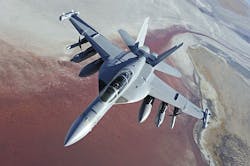U.S. airborne electronic warfare (EW) to hit 1.09 billion in 2016, drop to $950.6 million in 2019
Concerns for increasing airborne threats are prompting defense forces across the world to bolster their air defense capabilities with more airborne EW systems, Frost & Sullivan analysts say.
Airborne EW systems upgrades will generate more revenue than new systems development through 2018 because of defense budget constraints, yet fresh procurements and fleet replacements featuring new combat air platforms with modern EW systems will take the dominant position after 2018, analysts say.
EW systems providers best poised to succeed in the future will be those that can offer reduced hardware size, an extensive threat identity database, and wide coverage, Frost & Sullivan experts say.
EW systems developers through the rest of this decade will pay particular attention to adapting airborne EW systems to unmanned aerial vehicles (UAVs). These systems often will use EW systems for manned aircraft as a baseline, yet their use on UAVs will require reductions in size, weight, and power consumption (SWaP).
Related: Mercury gets another order for radar-spoofing airborne electronic warfare (EW) systems
Frost & Sullivan analysts outline their findings in a report entitled "Military Airborne Electronic Warfare (EW) Market in 14 Key Countries." The study assesses 14 key countries that are expected to be big spenders in the airborne EW domain: the U.S., Australia, Indonesia, Israel, Poland, Saudi Arabia, the United Kingdom, Turkey, Brazil, Germany, Norway, Sweden, Denmark, and Finland.
"NATO is driving EU nations to pool resources and increase their respective contributions to joint operations,” says Arun Kumar Sampathkumar, senior defense research analyst at Frost & Sullivan. “This will result in slow yet steady upgrade opportunities as forces make efforts to achieve the common architectures stipulated by the respective NATO doctrines.”
Europe has seen heightened interest in air missile defense systems due to Russia’s involvement in the conflicts in Eastern Ukraine and its military exercises along its western borders surrounding the High North and Baltic regions, analysts say. The defense spending in that region will cover air defense missile systems and suitable upgrades of air defense systems, including EW devices.
“The addition of a new EW system translates to sizeable upgrade orders for the system integrators that provide the overarching EW architecture,” Sampathkumar says.
For more information contact Frost & Sullivan online at www.frost.com.
